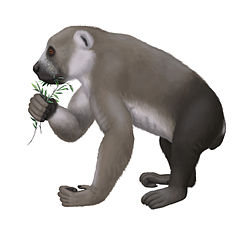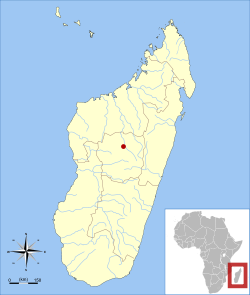- Archaeoindris
-
 Archaeoindris
Archaeoindris
Archaeoindris fontoynonti Classification Règne Animalia Embranchement Chordata Sous-embr. Vertebrata Classe Mammalia Sous-classe Theria Infra-classe Eutheria Ordre Primates Sous-ordre Strepsirrhini Infra-ordre Lemuriformes Famille Palaeopropithecidae Genre Archaeoindris
Standing, 1908[1]Espèces de rang inférieur †Archaeoindris fontoynonti Répartition géographique 
Synonymes Lemuridotherium Standing, 1910 
D'autres documents multimédia
sont disponibles sur CommonsArchaeoindris est un genre éteint de lémuriens originaire de Madagascar de la famille des Palaeopropithecidae. Il a été le plus grand des primates à évoluer sur Madagascar. Il pesait environ 200 kg et mesurait environ 1,5 m de hauteur[2], soit plus qu'un gorille « dos argenté ». Initialement, sa grande taille et l'anatomie de son fémur ont suggéré un mode de vie similaire à celui d'un paresseux vivant sur le sol et l'on croyait Archaeoindris être presque exclusivement terrestre[3],[4]. Lorsque plus de matériel fossile a été mis au jour, il s'est avéré que ses bras et ses jambes étaient plus adaptés pour une escalade lente, lourde. La courbure des phalanges chez les primates est corrélée avec la fonction de la main et du pied ; les espèces arboricoles comme l'orang-outan possèdent des phalanges plus incurvées. Les Palaeopropithecidae dont font partie Archaeoindris, se caractérisent par des phalanges proximales courbées, proches de celle des orangs-outans. Toutefois, on n'en a pas encore retrouvé[5].
Références
- (en) Cet article est partiellement ou en totalité issu de l’article de Wikipédia en anglais intitulé « Archaeoindris » (voir la liste des auteurs)
- (en) MC McKenna et SK Bell, Classification of Mammals: Above the Species Level, Columbia University Press, 1997 (ISBN 0-231-11013-6), p. 335
- William L. Jungers, Laurie R. Godfrey, Elwyn L. Simons, and Prithijit S. Chatrath, « Phalangeal curvature and positional behavior in extinct sloth lemurs (Primates, Palaeopropithecidae) », dans PNAS Proceedings of the National Academy of Sciences of the United States of America, vol. 94, no 22, 1997-10-28, p. 11998–12001
- Lamberton C. 1946. Bull Acad Malgache. 27:24–28.
- Jungers W L. 1980. Z Morphol Anthrop. 71:177–186.
- Jungers W.L. et al 1997. Phalangeal curvature and positional behavior in extinct sloth lemurs (Primates, Palaeopropithecidae). PNAS 94, p11998–12001.
Liens externes
- Référence The Paleobiology database : Archaeoindris Standing 1908 (en)
Catégories :- Lemuriformes
- Mammifère disparu
Wikimedia Foundation. 2010.
